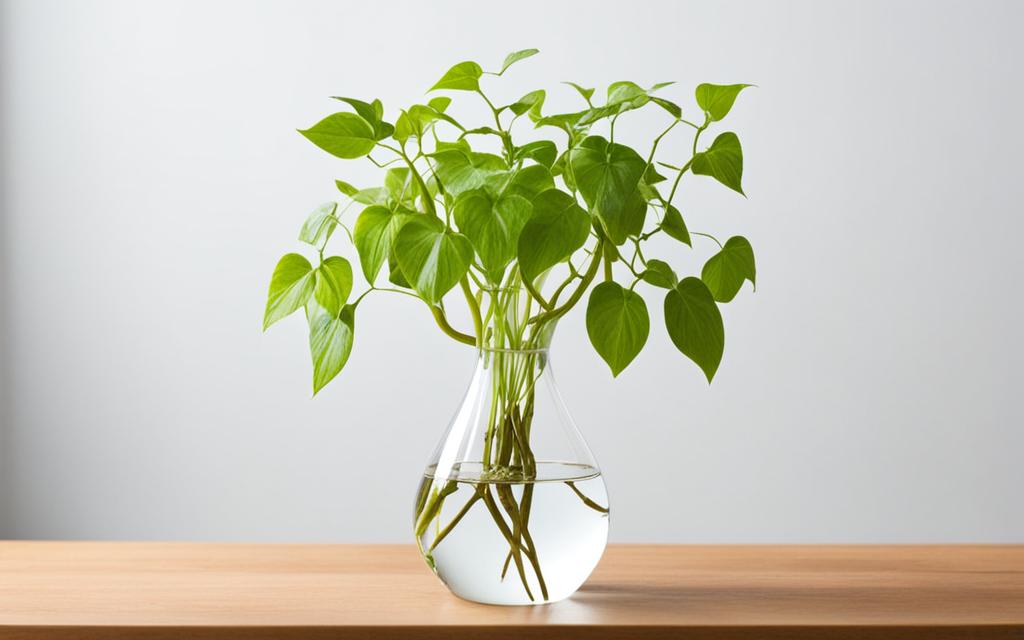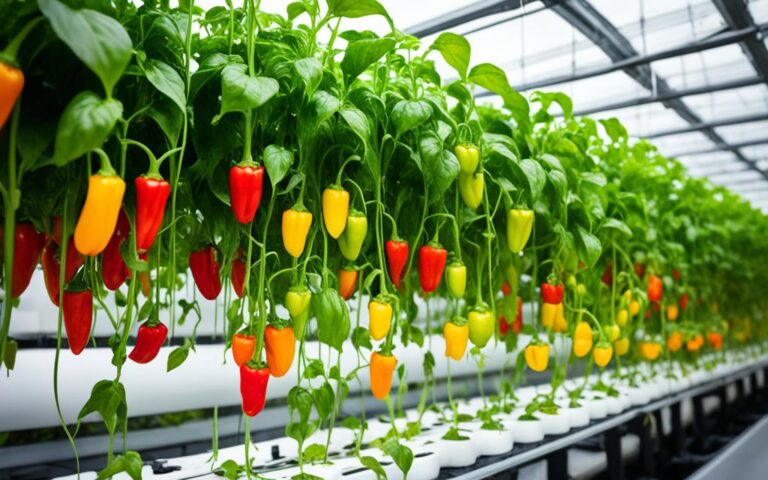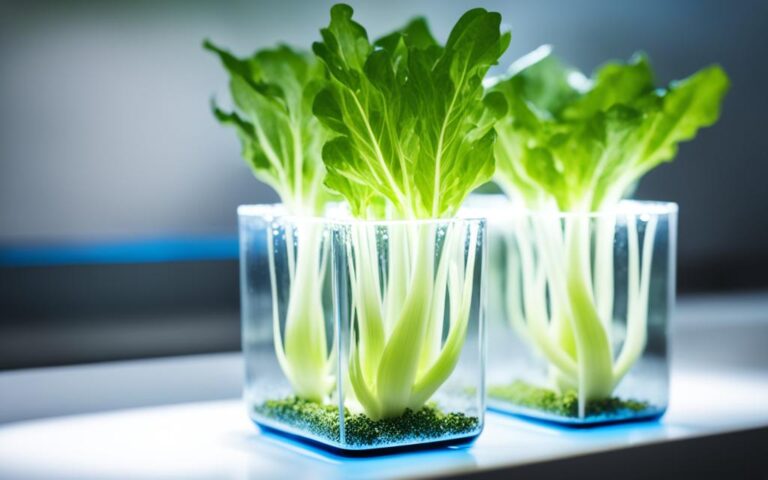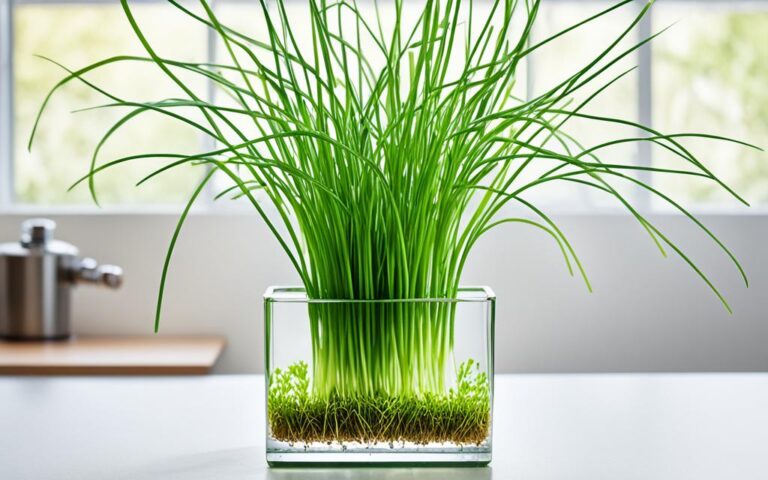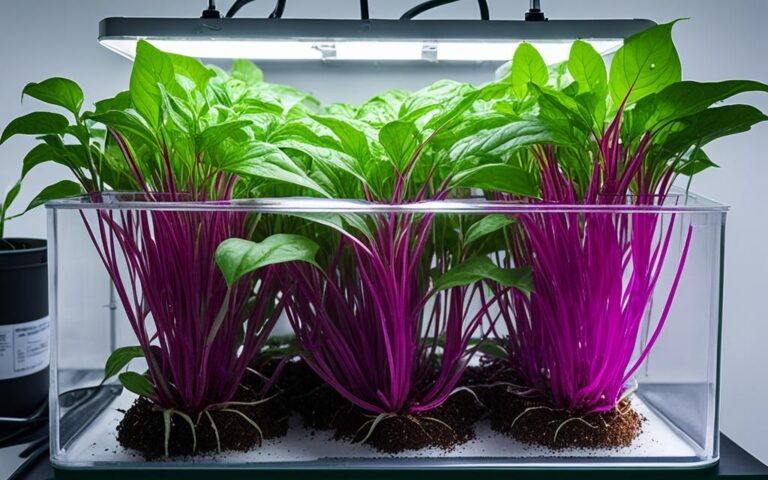Grow Hydroponic Arrowhead Vine at Home Easily
Did you know most homes have 3 to 5 air-cleaning plants? The arrowhead vine, or Syngonium podophyllum, is a top choice for cleaning the air. It can remove up to 90% of harmful toxins from inside your home. Now, with hydroponic gardening, you can grow this beautiful vine at home without soil.
Hydroponic arrowhead vine growing is a clean, simple way to garden. It uses a water-based system instead of soil. This means you get to enjoy its lovely leaves and clean air without the mess of soil. It’s perfect for both experienced gardeners and beginners who want to try vertical gardening.
Key Takeaways
- Arrowhead vines (Syngonium podophyllum) are effective air-purifying plants that can remove up to 90% of indoor toxins.
- Hydroponic cultivation allows you to grow arrowhead vines without soil, creating a clean and minimalist indoor garden.
- Hydroponic arrowhead vine cultivation is a relatively easy and rewarding process for both experienced and beginner indoor gardeners.
- Understanding the specific light, nutrient, and environmental requirements for hydroponic arrowhead vine growth is key to successful cultivation.
- Hydroponic arrowhead vines can be grown as ornamental plants, providing beautiful foliage and air-purifying benefits for your home or office.
Introduction to Hydroponic Arrowhead Vine Cultivation
Hydroponic gardening is becoming more popular, offering a clean way to grow plants like the arrowhead vine. It doesn’t need soil, which brings many benefits for gardeners at home and indoors.
One big plus of growing arrowhead vine hydroponically is less risk of root rot. This is a common problem in soil gardens. Hydroponics lets you control moisture levels, keeping the roots healthy and the plant strong.
Soil-free gardening with hydroponics is also neat and clean. It’s great for those with little space or who like a simple, minimalist indoor plant look. You don’t have to repot often, unlike with soil gardens.
“Switching to hydroponic arrowhead vine cultivation can change the game for city gardeners and plant lovers who want a tidy and efficient indoor garden.”
Hydroponic systems need extra care, like regular feeding with nutrients. But, the advantages often make it worth it for those wanting an easy and beautiful way to grow this lovely plant.
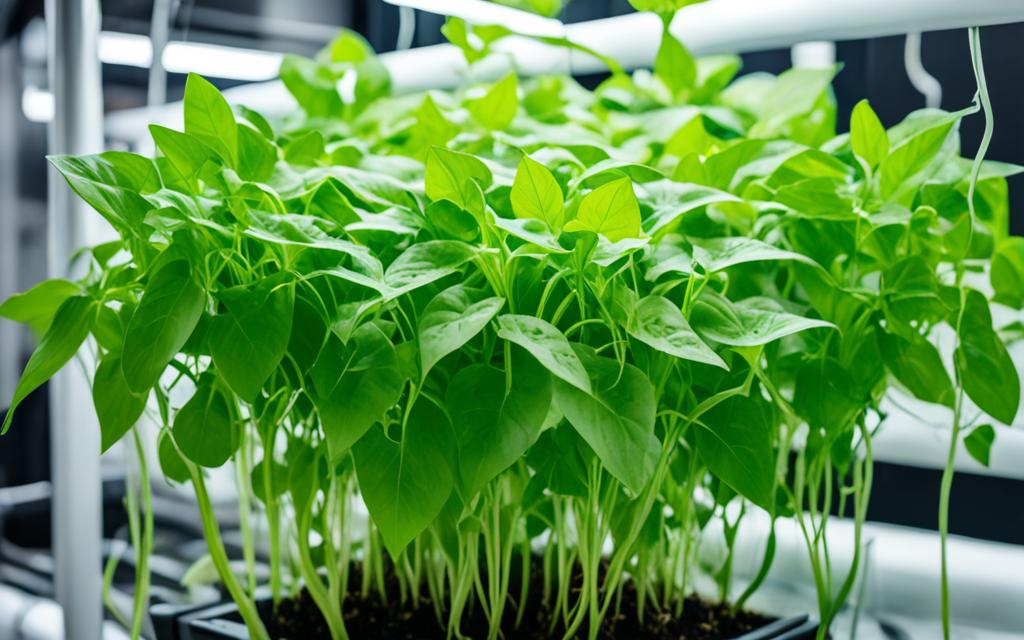
Selecting and Preparing Arrowhead Vine Plants
Choosing the right arrowhead vine for hydroponics is key to success. Look for compact, non-trailing types like ‘Falling Arrows Snow White’ and variegated ones such as ‘Falling Arrows White Butterfly’ and ‘Albo Variegatum’. These are great for hydroponic systems and perfect for home growers.
Best Hydroponic Varieties
Arrowhead vines vary in shape, size, and color, but not all work well in hydroponics. The best ones are compact and bushy, with little to no trailing. Here are some top picks:
- Falling Arrows Snow White – A compact, upright variety with pure white leaves
- Falling Arrows White Butterfly – A variegated cultivar with green and white foliage
- Albo Variegatum – A classic variegated arrowhead vine with green, white, and pink leaves
Starting from Seeds vs. Transplants
You can grow arrowhead vines from seeds or cuttings. Seeds let you start from the beginning but take longer to get a strong plant. Cuttings, however, root quickly in water and can be moved to hydroponics fast. Make sure to pick healthy, pest-free plants for your hydroponic system.
Setting Up Your Hydroponic System
Choosing the right hydroponic system for your arrowhead vine is key to its success. There are many types of hydroponic systems for indoor plants, each with its own benefits and needs.
The deep water culture (DWC) system dips the roots in an oxygen-rich nutrient solution. DWC systems are easy to start and keep up, perfect for new hydroponic gardeners.
The ebb and flow (or flood and drain) system also works well. It fills the roots with nutrients, then drains it, giving the plant what it needs.
If you’re short on space, think about a drip system. This method sends a steady flow of nutrients right to the roots with a timer-controlled pump.
When picking the best hydroponic system for arrowhead vine, think about space, upkeep, and what you like. Make sure the system gives enough oxygen, nutrients, and drainage for your vine to thrive.
| Hydroponic System | Key Features | Pros | Cons |
|---|---|---|---|
| Deep Water Culture (DWC) | Submerges roots in oxygenated nutrient solution | Simple setup, low maintenance | Requires careful monitoring of water levels and pH |
| Ebb and Flow (Flood and Drain) | Periodically floods and drains the root zone | Efficient nutrient delivery, good oxygenation | Requires more complex setup and monitoring |
| Drip System | Delivers nutrient solution directly to the roots | Suited for limited spaces, low water usage | Potential clogging issues, requires regular maintenance |
By picking the best hydroponic system for arrowhead vine, you can give your plant the best growing conditions. This way, you can make the most of your indoor hydroponic arrowhead vine cultivation.
Nutrient Management for Hydroponic Arrowhead Vine
Getting the right hydroponic arrowhead vine nutrients is key to growing this plant well in a hydroponic setup. Arrowhead vines don’t get nutrients from soil. So, they need a special fertilizer for hydroponic arrowhead vine. This fertilizer must have the main nutrients like nitrogen, phosphorus, and potassium. It also needs important micronutrients like calcium, magnesium, and iron.
Essential Nutrients for Plant Growth
For the best growth, hydroponic arrowhead vines need a nutrient mix with these key elements:
- Macronutrients: Nitrogen (N), Phosphorus (P), and Potassium (K) for growth and health.
- Micronutrients: Calcium, Magnesium, Iron, Boron, Manganese, Copper, Zinc, and Molybdenum for enzymes, chlorophyll, and roots.
pH, TDS, and EC for Optimal Growth
Keeping the water right is vital for your hydroponic arrowhead vine. You should check and adjust these water factors often:
- pH: Keep the pH between 5.5 and 6.5 for best nutrient use.
- Total Dissolved Solids (TDS): Keep TDS between 800 to 1200 ppm for balanced nutrients.
- Electrical Conductivity (EC): Aim for EC levels of 1.2 to 2.0 mS/cm for the right salt and mineral levels.
By keeping an eye on and adjusting these water factors, you can make the best environment for your hydroponic arrowhead vine.
Light and Temperature Requirements
To get your hydroponic arrowhead vine to grow well, pay close attention to its light and temperature needs. These factors are key for keeping the plant healthy and vibrant.
Types of Grow Lights
Arrowhead vines can live with little light but do best in bright, indirect light. If you don’t get enough natural light, especially in winter or dark places, use grow lights. Here are some options:
- LED Grow Lights – These lights use less energy and give off the right light for plants to grow well.
- Fluorescent Grow Lights – These are a budget-friendly choice that also work well for your arrowhead vine.
It’s important to give your plants 12-14 hours of light each day for the best growth.
| Lighting Requirements | Temperature and Humidity |
|---|---|
|
|
Arrowhead vines also need a warm, humid place with temperatures between 65°F and 85°F. Keep them away from cold air and sudden temperature changes. This helps prevent stress and keeps them growing well.
Propagating Arrowhead Vine Hydroponically
Want to grow more arrowhead vines or share them with friends? Propagating them in water is easy and effective. You can do it right in a hydroponic system.
Start by picking healthy, 4-6 inch stem sections of your propagating arrowhead vine in water. Each cutting should have at least one node. Remove any lower leaves. Then, put the cuttings in clean, fresh water, making sure the nodes are fully covered.
Keep the water clean and change it every 2-3 days. This helps prevent disease and helps the rooting arrowhead vine in water. In a few weeks, you’ll see tiny roots coming out of the nodes. This means your hydroponic arrowhead vine cuttings are growing well.
When the roots are strong, you can keep them hydroponic or move them to soil. Propagating arrowhead vines in water is a great way to grow more plants or share them with others.
“Propagating arrowhead vines in water is a fun and rewarding way to grow your plant family and share your love of gardening with others.”
Maintaining Root Health
Keeping your hydroponic arrowhead vine’s roots healthy is key for its success. It’s important to check on the roots often. This helps in caring for arrowhead vine roots in hydroponics and preventing root rot in hydroponic arrowhead vine.
Healthy roots look white or light, feel firm, and are plump. If you see roots that are discolored, soft, or smell bad, they might be rotting. To monitor root health of hydroponic plants, take the plant out of its water and look at the roots closely.
Root Health Checks
When checking the roots, watch for these signs:
- Healthy roots should be white or light-colored, firm, and plump.
- Discoloration, mushiness, or a foul odor may indicate root rot or other problems.
- Trim off any damaged or unhealthy portions using clean, sterilized tools.
Keeping the water clean and full of oxygen helps prevent root rot in hydroponic arrowhead vine. Regular checks and quick action can keep your hydroponic arrowhead vine healthy and strong.
“Healthy roots are the foundation of a thriving hydroponic arrowhead vine. Regular root health checks can make all the difference in the success of your hydroponic garden.”
Hydroponic Arrowhead Vine Care and Maintenance
To keep your hydroponic arrowhead vine healthy, follow a few key steps. Make sure the roots are always moist but not in water. Feed your plant with a special indoor, hydroponic fertilizer every few weeks. This gives it the nutrients it needs for growth and pruning.
Pruning helps keep your plant looking good and encourages more growth. Cut off any stems that are too long or unwanted right above a leaf node. Watch out for pests or diseases and deal with them quickly to keep your hydroponic arrowhead vine in great shape.
Proper Watering and Feeding
Watering your hydroponic arrowhead vine regularly is key. Make sure the roots are moist but don’t let the plant sit in water. This can cause root rot. Feed your vine a diluted liquid fertilizer made for indoor, hydroponic plants every two to three weeks. This ensures it gets the nutrients it needs for hydroponic arrowhead vine growth and pruning.
Pruning for Shape and Vigor
Pruning your arrowhead vine often helps it stay in shape and grow bushier. Cut off any stems that are too long or unwanted just above a leaf node. This encourages the plant to focus on growing more compact, full foliage. Doing this will keep your caring for hydroponic arrowhead vine looking great.
Vigilance for Pests and Diseases
Watch for any pests or diseases on your hydroponic arrowhead vine. Deal with any problems quickly to stop them from getting worse. This will help keep your maintaining hydroponic arrowhead vine healthy and thriving.
“Properly caring for your hydroponic arrowhead vine is the key to a lush, vibrant plant that will thrive in your indoor growing space.”
Common Issues and Troubleshooting
Hydroponic arrowhead vine cultivation has many benefits, but it also comes with challenges. Plants in hydroponic systems may face pests, diseases, and nutrient issues. These problems need quick attention and effective solutions.
Identifying and Addressing Pests and Diseases
Keep a close eye on your hydroponic arrowhead vine to spot pests or diseases early. Watch out for pests like aphids, mealybugs, spider mites, and thrips. These pests can harm the plant’s leaves and health. Diseases such as root rot and powdery mildew can also occur if the conditions are not right.
- Isolate any affected plants to prevent the spread of pests or diseases.
- Remove any damaged or infected leaves or stems to limit the issue’s progression.
- Treat the plant with appropriate organic or chemical controls, following the manufacturer’s instructions carefully.
Addressing Nutrient Deficiencies
Nutrient imbalances in hydroponic solutions can cause problems like yellow leaves and stunted growth. Keep an eye on the plant’s look and test the nutrient levels, pH, and EC regularly. This helps spot and fix nutritional issues.
- Adjust the nutrient mix to ensure the arrowhead vine gets the right balance of nutrients.
- Keep the pH between 5.5 and 6.5 for better nutrient uptake.
- Check the TDS and EC levels often to avoid a solution that’s too diluted or too concentrated.
By staying alert and fixing problems quickly, you can keep your hydroponic arrowhead vine healthy and thriving.
Maximizing Yield of Hydroponic Arrowhead Vine
To grow a thriving hydroponic arrowhead vine, you need to balance several key factors. Make sure your plants get enough light, manage nutrients well, and keep their roots healthy. This will boost your indoor arrowhead vine garden’s yield and look.
For a better arrowhead vine yield in hydroponics, give your plants lots of light. Use grow lights to help with photosynthesis and make the leaves look lush. It’s also important to keep the nutrients and pH in your system right. Check and adjust the nutrient solution often to support your plants’ growth.
Good root care is vital for a productive hydroponic arrowhead vine. Make sure the roots are well-aired and not too wet. Check for diseases or pests and fix any problems fast. This keeps the plant healthy and productive.
Try pruning to get more from your vine. Cutting back the plant encourages more growth and makes it look fuller. Use these hydroponic techniques for high-yielding arrowhead vine together for the best results. This way, you can make the most of your indoor arrowhead vine garden.
“The key to maximizing arrowhead vine yield in hydroponics lies in a holistic approach, addressing the plant’s diverse needs for light, nutrients, and root health.”
Arrowhead Vine Varieties for Hydroponics
Choosing the right arrowhead vine varieties for hydroponics is key. Look for cultivars that fit well with this method. Compact, non-trailing types like ‘Falling Arrows Snow White’ and ‘Mini Pixie’ are great options.
These varieties stay bushy and don’t spread out too much. They’re perfect for indoor growing in hydroponic systems. Variegated types like ‘Falling Arrows White Butterfly’ and ‘Albo Variegatum’ also do well. They show off beautiful foliage patterns with the right light.
If you want vines with deeper colors, try ‘Pink Splash’ and ‘Berry Allusion’. They need good light to thrive in hydroponics. Picking the right variety ensures a beautiful and successful hydroponic setup.
- Compact and non-trailing arrowhead vine cultivars like ‘Falling Arrows Snow White’ and ‘Mini Pixie’
- Variegated arrowhead vine types such as ‘Falling Arrows White Butterfly’ and ‘Albo Variegatum’
- Richly colored arrowhead vine varieties including ‘Pink Splash’ and ‘Berry Allusion’
“Selecting the right arrowhead vine variety for your needs and growing environment can ensure a rewarding and visually stunning hydroponic experience.”
Benefits of Growing Arrowhead Vine Hydroponically
Choosing to grow arrowhead vine hydroponically changes your indoor gardening for the better. It means no more dealing with messy soil. Hydroponic systems are clean and easy to take care of.
They also let you control the moisture, which means less chance of root rot. This is a big plus for those who worry about their plants.
Arrowhead vines grow faster and look better when grown hydroponically. You can adjust the light, temperature, and nutrients for your plant. This makes sure it gets exactly what it needs to thrive.
If you have little space or like a clean look, hydroponics is perfect. Arrowhead vines are great for it because they don’t take up much room. They can hang down beautifully, adding a touch of green to any spot.
| Advantage | Benefit |
|---|---|
| Soil-free cultivation | Eliminates the need for potting mixes and associated mess, creating a clean and low-maintenance growing experience |
| Moisture control | Reduces the risk of root rot and other water-related issues that can plague soil-based plantings |
| Controlled environment | Promotes faster growth and more vibrant foliage by precisely regulating factors like light, temperature, and nutrient delivery |
| Compact and trailing nature | Makes arrowhead vine cultivars well-suited for hydroponic growing, allowing you to enjoy their striking beauty with ease in limited spaces |
If you’re new or experienced with hydroponics, the advantages of growing arrowhead vine hydroponically are clear. Leveraging the benefits of these soil-free systems lets you grow beautiful arrowhead vines. It opens up new possibilities for your indoor garden.
“Hydroponic gardening has revolutionized the way I grow my arrowhead vine. The controlled environment and precision of nutrient delivery have led to incredible results.”
– Avid Indoor Gardener
Conclusion
Hydroponic growing is a clean, efficient way to grow arrowhead vines indoors. It meets their needs for light, nutrients, water, and temperature. This way, these plants can thrive and make your space look beautiful.
Adding an arrowhead vine to your indoor garden is rewarding for both experts and beginners. The article gives you the main steps and tips for growing these plants well. By choosing hydroponics, you can have a green oasis at home and improve the air quality.
There are many benefits to growing arrowhead vines hydroponically. This method is great for both experienced and new gardeners. By using the advice in this article, you can make the most of these plants’ beauty and air-purifying qualities for years.
